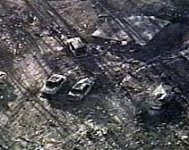Ummm...This is why I said that even filling on the ground, I touch the nozzle to the can before turning on the pump. It doesn't matter at that point if the can is on the ground, bed, or moon, both objects have the same ground.
It's real easy to point a finger, read a label, and say you're wrong. I have a degree in electronics and know that when 2 objects make contact, it doesn't matter where they are, they share the same ground.
You are very wrong.

To be considered grounded we have to drive 2 copper rods 6 foot into the earth and connect them together to get a low enough impedence to current flow for it to be considered grounded in our soil conditions. I know this because I just installed an electrical service to my house.
While pumping gas into a plastic can the charge can build up because of the gas sloshing on the plastic and the free fall of the gas through the air in the head space of the can will also generate a charge. While the fuel is flowing the danger is slight because the charge can blead back through the liquid to the nozzle that is grounded. As soon as the flow stops, all bets are off. If there is enough of a charge in the liquid it will try to go to ground. Its only path is to jump through the now vapor filled head space of the can to the nozzle on the pump.

I have a degree in nothing, however I have 35 years experience as a mechanical designer in the chemical and nuclear industry. Solids and liquids moving through air, pipe and hose will build up a charge and if the charge isn't bled off to ground without the generation of a spark bad things can happen.
Everything in a chemical plant is grounded, and the impedence of the grounds are checked to make sure that corrosion and soil conditions haven't degraded them.
Several large ships and barges have been lost to static discharge during loading and unloading operations. We saw the results of many of these accidents in our safety training films. If a metal ship sitting in water isn't grounded enough to prevent an explosion it is unlikely that a plastic container sitting on dry asphalt or concrete has much of a chance of bleeding off an electrical charge to ground.
It has been suggested that it was static electricity that leveled a fire works factory near my house in Hillsdale several years ago. The explosion was so great that the only thing left of the factory was the cement slab. The force of the blast excavated a shallow wide trench completely around the perimeter of the slab. All the employees were killed. The attached photo shows whatwas left of the factory.
Take a look at these photo's. 600 people died possibly because somebody didn't understand this principle....
It has been suggested that static discharge caused this, but we will never know for sure.
Texas City Disaster Pictures
